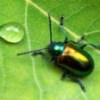The genome sequence of the pea aphid Acyrthosiphon pisum was published today in PLoS. Concurrently, a set of supporting papers has come out in Insect Molecular Biology. This genome is significant for a number of reasons- it's the first Hemipteran genome to be sequenced, aphids have an unusual reproductive cycle, and this particular species is a serious agricultural pest.
I've not had time to fully digest the paper, but it seems the salient features of this genome are:
- extensive gene duplications
- a higher gene count than most other known genomes (including our own!), perhaps related to all the duplications
- a surprising loss of immune genes
source:Â The International Aphid Genomics Consortium 2010 Genome Sequence of the Pea Aphid Acyrthosiphon pisum. PLoS Biol 8(2): e1000313. doi:10.1371/journal.pbio.1000313
More like this
You really don't want to be an enemy of the aphids - two papers today! The first is quite straightforward:
Aphids Make 'Chemical Weapons' To Fight Off Killer Ladybirds:
Where there are plants, there are almost certainly aphids feeding on them


I have nothing interesting to say here, but that photo is AMAZING.
Hee. It looks like a crossing guard with a bunch of littles. All you're missing is backpacks.